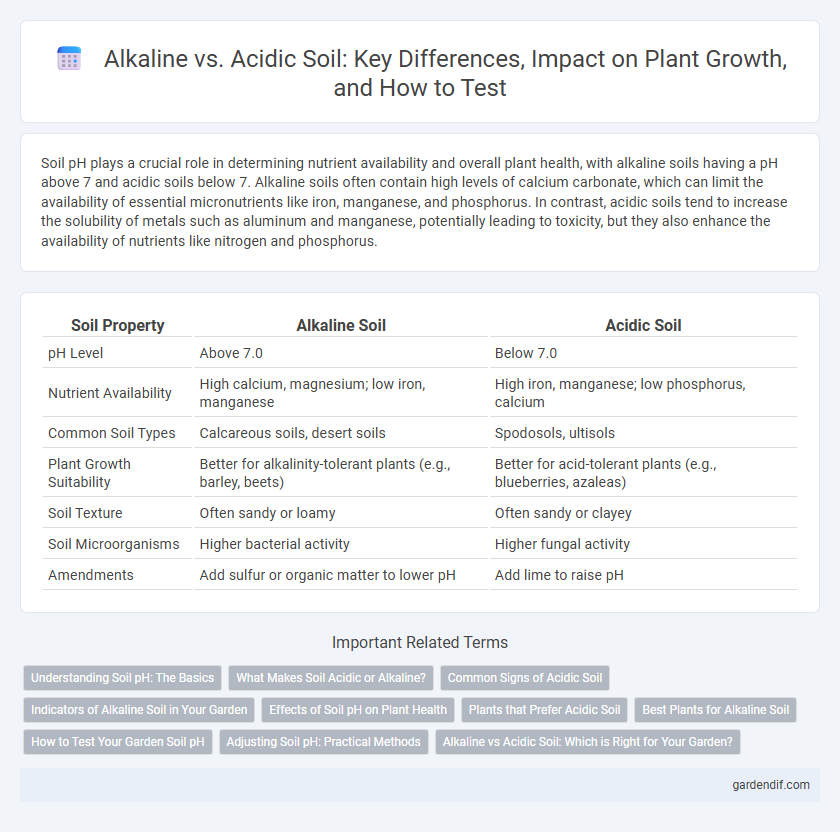
Alkaline vs Acidic Illustration
Soil pH plays a crucial role in determining nutrient availability and overall plant health, with alkaline soils having a pH above 7 and acidic soils below 7. Alkaline soils often contain high levels of calcium carbonate, which can limit the availability of essential micronutrients like iron, manganese, and phosphorus. In contrast, acidic soils tend to increase the solubility of metals such as aluminum and manganese, potentially leading to toxicity, but they also enhance the availability of nutrients like nitrogen and phosphorus.
Table of Comparison
| Soil Property | Alkaline Soil | Acidic Soil |
|---|---|---|
| pH Level | Above 7.0 | Below 7.0 |
| Nutrient Availability | High calcium, magnesium; low iron, manganese | High iron, manganese; low phosphorus, calcium |
| Common Soil Types | Calcareous soils, desert soils | Spodosols, ultisols |
| Plant Growth Suitability | Better for alkalinity-tolerant plants (e.g., barley, beets) | Better for acid-tolerant plants (e.g., blueberries, azaleas) |
| Soil Texture | Often sandy or loamy | Often sandy or clayey |
| Soil Microorganisms | Higher bacterial activity | Higher fungal activity |
| Amendments | Add sulfur or organic matter to lower pH | Add lime to raise pH |
Understanding Soil pH: The Basics
Soil pH measures the acidity or alkalinity of soil on a scale from 0 to 14, with 7 being neutral; values below 7 indicate acidic soil, while those above signify alkaline conditions. Acidic soils (pH < 7) often contain higher concentrations of hydrogen ions, affecting nutrient availability such as phosphorus, calcium, and magnesium, while alkaline soils (pH > 7) can limit the uptake of micronutrients like iron, manganese, and zinc. Understanding soil pH is crucial for optimizing plant growth, as it influences microbial activity, nutrient solubility, and overall soil health.
What Makes Soil Acidic or Alkaline?
Soil acidity or alkalinity is primarily determined by the concentration of hydrogen ions (H+) and hydroxide ions (OH-) present in the soil solution, measured as pH. Acidic soil typically results from high levels of organic matter decomposition, acid rain, or leaching of basic cations such as calcium, magnesium, and potassium. Alkaline soil often forms in arid regions due to the accumulation of calcium carbonate, sodium bicarbonate, and other base cations that neutralize acidity and increase pH levels.
Common Signs of Acidic Soil
Acidic soil commonly exhibits signs such as poor plant growth and yellowing leaves due to nutrient deficiencies, especially iron and magnesium. Slow decomposition of organic matter and increased presence of moss or certain fungi often indicate low pH levels ranging below 6.0. These conditions can lead to stunted root development and reduced microbial activity, affecting overall soil fertility.
Indicators of Alkaline Soil in Your Garden
Indicators of alkaline soil in your garden include poor growth of acid-loving plants, such as azaleas and blueberries, along with yellowing leaves caused by nutrient deficiencies. Soil testing revealing a pH level above 7.0 confirms alkalinity, while the presence of white, powdery residue or crust on the soil surface often signals high sodium or calcium carbonate content. These signs help gardeners identify alkaline soil conditions to adjust soil amendments and improve plant health effectively.
Effects of Soil pH on Plant Health
Soil pH significantly influences nutrient availability and microbial activity, with alkaline soils often causing deficiencies in iron, manganese, and phosphorus, leading to chlorosis and stunted growth in plants. Acidic soils can increase the solubility of toxic metals like aluminum and manganese, which harm root development and reduce nutrient uptake. Maintaining optimal soil pH between 6.0 and 7.5 enhances plant health by ensuring balanced nutrient availability and promoting beneficial microbial processes.
Plants that Prefer Acidic Soil
Plants that prefer acidic soil typically thrive in pH levels below 7, such as azaleas, blueberries, and rhododendrons. Acidic soil enhances the availability of essential nutrients like iron, manganese, and phosphorus, which are critical for these plants' growth and health. Maintaining soil pH through the addition of organic matter or sulfur helps support optimal acidic conditions for acid-loving plants.
Best Plants for Alkaline Soil
Alkaline soil, characterized by a pH above 7.0, supports plants that thrive in higher pH environments such as lavender, lilac, and clematis. These plants exhibit optimal nutrient uptake and growth in soils rich in calcium carbonate and low in acidity. Choosing species like yarrow, sedum, and ornamental grasses can enhance garden health and aesthetics in alkaline soil conditions.
How to Test Your Garden Soil pH
Testing garden soil pH involves using a soil pH test kit or a digital pH meter to measure acidity or alkalinity accurately. Collect soil samples from multiple spots in your garden at a depth of 4-6 inches for a representative test, then mix them to create a composite sample. Follow the instructions of your chosen testing method, ensuring results guide appropriate soil amendments like lime for acidic soil or sulfur for alkaline soil.
Adjusting Soil pH: Practical Methods
Adjusting soil pH involves adding lime to acidic soils to increase alkalinity, while sulfur or aluminum sulfate can lower pH in alkaline soils. Monitoring pH levels regularly ensures optimal nutrient availability and healthy plant growth. Incorporating organic matter such as compost also helps buffer soil pH by improving soil structure and microbial activity.
Alkaline vs Acidic Soil: Which is Right for Your Garden?
Alkaline soil, with a pH above 7.0, often contains high levels of calcium carbonate and supports plants like lavender, cabbage, and clematis. Acidic soil, having a pH below 7.0, is rich in organic matter and ideal for azaleas, blueberries, and rhododendrons that thrive in lower pH environments. Understanding the pH preference of your garden plants is crucial to amending the soil appropriately for optimal growth and nutrient absorption.
Alkaline vs Acidic Infographic

 gardendif.com
gardendif.com